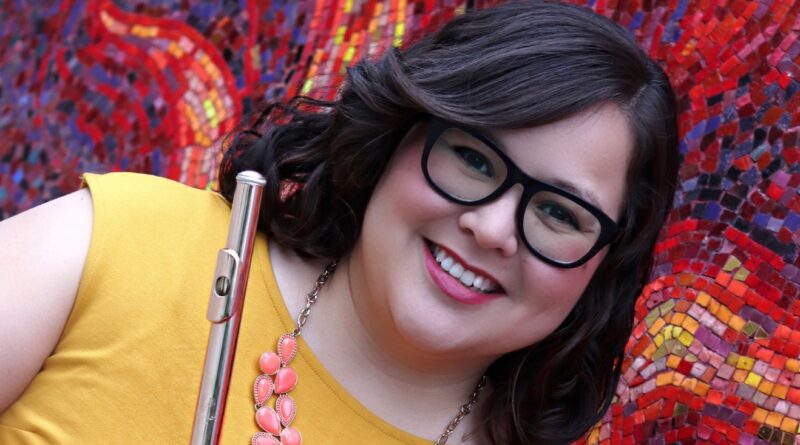Navigating A Disability in Music by Maria Gabriela Alvarado
Venezuelan Native Maria Gabriela (Gaby) Alvarado is a modern and baroque flutist with a passion for bringing classical music to nontraditional spaces. Gaby has worked in the performing arts community as a facilitator, grant panelist, educator, speaker, and consultant. She is the Manager of Community and Patron Engagement for the Sphinx Organization. She is a board member of the International Alliance for Women Music and the Advisory Council on Diversity, Equity, and Inclusion at the University of North Texas.
Navigating a world that is not welcoming to people like me!
I was diagnosed with Ehlers Danlos Syndrome (EDS) in 2017 - a rare condition that affects connective tissues. Generally, EDS is characterized by joint hypermobility, joint instability and dislocations, scoliosis and other joint deformities, skin hyperextensibility, abnormal scarring, and other structural weakness such as hernias and organ prolapse through the pelvic floor. As the entire body is connective tissue, every organ in the body can present issues. In my case, specifically, the heart and digestive system are the worst. Now, you might be wondering why all the medical terms?
My journey in music started at an early age in Barquisimeto - my hometown in Venezuela - through El Sistema. Founded in Venezuela in 1975 by the visionary musician and economist José Antonio Abreu, El Sistema is a cultural, educational, and social program that pursues social engagement and youth empowerment through ensemble music education. I started playing the flute at 11 years old. While not always the most welcoming place, classical music has given me opportunities I wouldn’t otherwise have lived. This unique background shaped my mission of making music widely accessible to all. I achieve this are through concert programming, booking non-traditional venues, and tailoring my teaching to each individual. In my current administrative roles, I have become the voice of those who are generally not heard.
Now that I know more about my medical condition, I can recall having dislocations in my fingers, arms, shoulders, ribs, and what many called “panic attacks” - but really have been severe episodes of arrhythmia and tachycardia - from an early age. These only got worse as my career took off, and the longer the rehearsals, concerts, playing time became, the more time I needed to take time off of my instrument, constantly getting injured. When I acknowledged the pain, this was often treated as a lack of preparation, bad technique, and I was asked to ignore it. Until my body decided to collapse entirely, and I ended up in the hospital for weeks and later bedridden for months due to complications. While my case is more complicated (due to the nature of my genetic condition), addressing my complaints from the start by teachers, mentors, and doctors, who often ignored my symptoms, could have avoided a lot of pain. But that is a bigger issue to be discussed at a different time!
The complexity of my medical conditions qualifies me as a person with disabilities. According to the law, a person with a disability is someone who has a physical or mental impairment that substantially limits one or more life activities for a prolonged period of time. These activities include reading and writing, dressing, cooking, exercising, or playing an instrument, just to name a few. My disability has made me become not only a better musician but a better educator and teacher. Making music accessible to me also means finding ways to get everyone the accommodations they need to succeed as they perform, including those of us with disabilities.
Through my different experiences as a person with disabilities, I have learned to navigate an industry that is not always welcoming to out-of-the-ordinary situations. The following suggestions I have found helpful in most musical environments as a performer, collaborator, student, and teacher. I hope to provide insightful advice to our community:
- Whether you are a lesson teacher, conductor, or classroom teacher - Please listen to the feedback your student is providing! If they say they are in pain, find a way to help or direct them to someone that can.
- Hypermobility in one or more parts of the body is more common than expected. If your student is double-jointed, using devices to protect their joints can prevent serious injuries:
- Oval 8 Finger Splint - these come in different sizes. You can find them online!
- Wrist braces
- Thumb ports
- KT Tape to reinforce/stabilize joints
- Recommending physical therapy as preventing measures or when suspicion of injuries
- Incorporate an appropriate stretching routine as part of practice time.
- Schedule breaks as part of rehearsals, lessons, and classes.
- Coloring over sheet music can help with reading as many can struggle with black and white.
- Offer options for those that will need enlarged sheet music.
- Have accessible entrances and elevators for those that have mobility devices.
- Incorporate mindfulness and body awareness as part of the overall training and musicianship.
- Provide access to chairs of different heights.
- Designate accessible parking to and from rehearsal spaces.
More importantly, create a safe space to ensure success and beautiful music-making to the best of everyone's abilities!
Gabriela Alvarado
IG: @gabyflute
Facebook: https://www.facebook.com/gabyalvaradoflute/

Good on you for discovering opportunities that might appear to be road-blocks to other people. Because you learned to help yourself you are now able to help other musicians to learn/perform in a positive and accepting environment. Sending much respect your way!